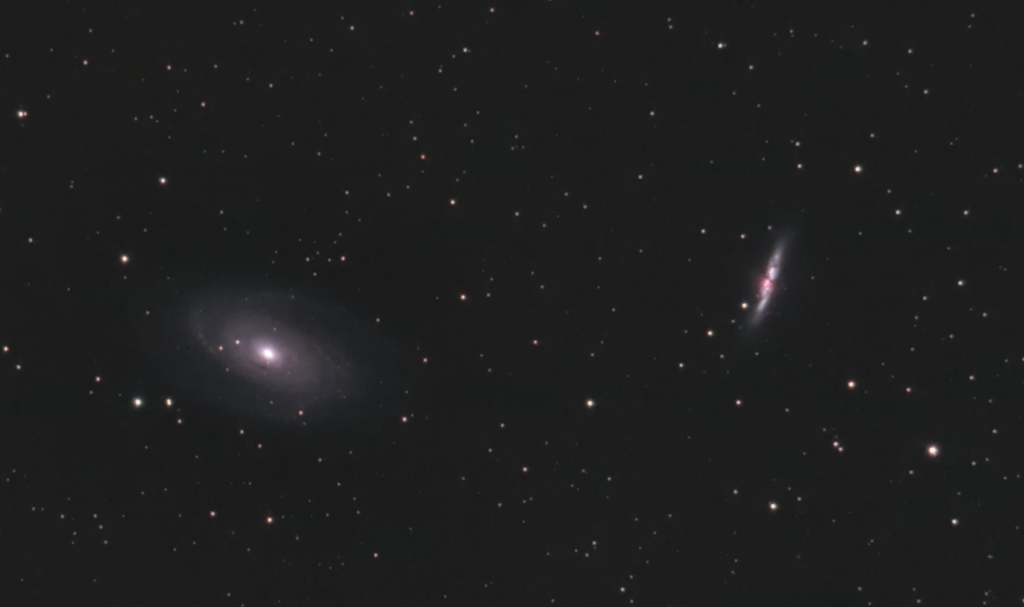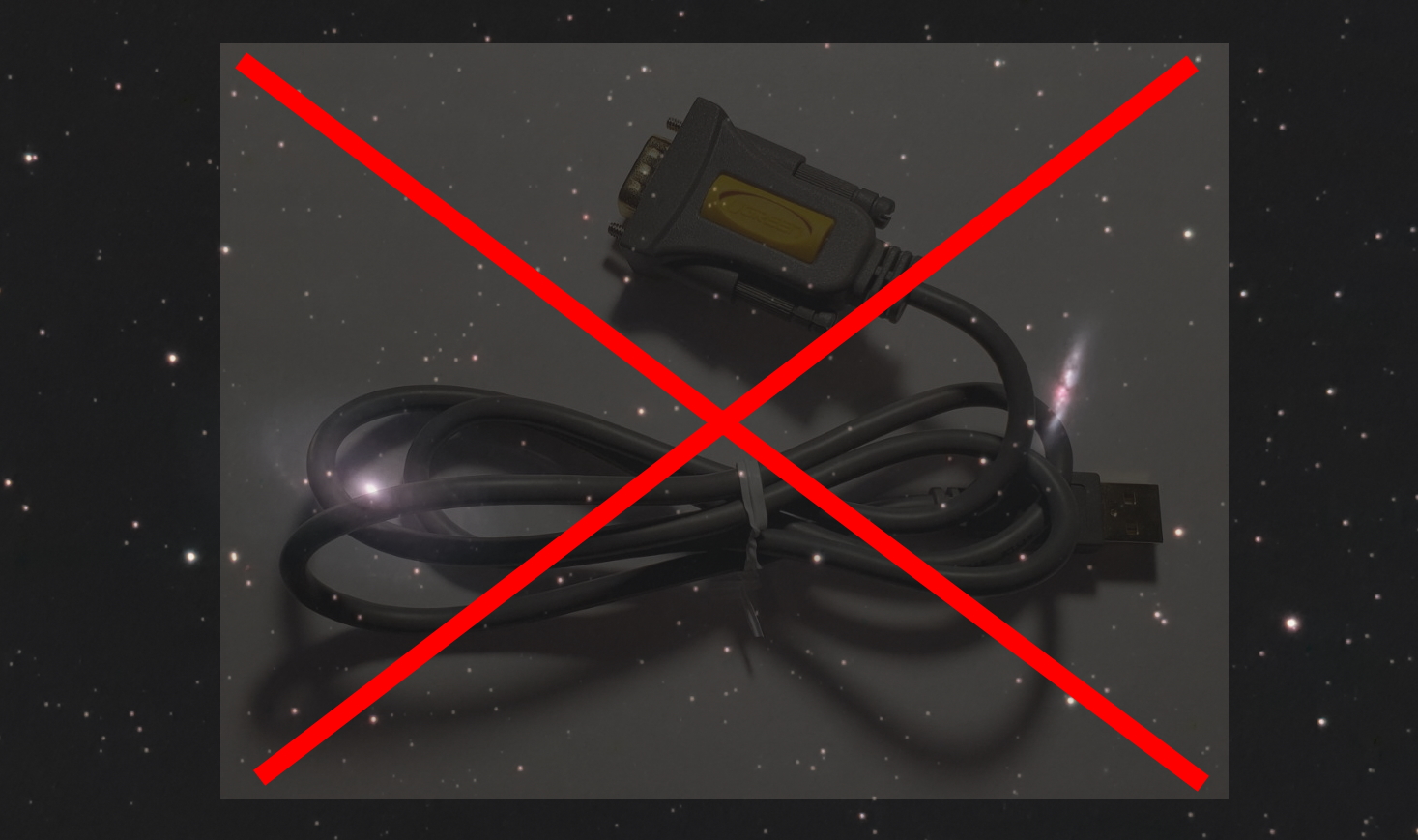Control Issues
This is a very long and rambling post with lots of technical stuff. If you’re just here for the pictures, then scroll to the bottom. If you’re here because you are trying to solve PC-to-mount connection issues or cannot get an old guide camera to work, then read on. And if you’re that spam bot that is trying to gain access to my comments section, please just stop. I moderate every single comment. You’re just wasting my time.
I’ve been working with computers for over 40 years now. During that time I have seen a lot of state-of-the-art technologies come and go. Among them are interfaces and their related cables.
When I got into this hobby in 2008, I was surprised that a lot of astronomy-related equipment used interfaces that were, even at that time, considered obsolete or at least passe. One of these was the interface between the mount and the computer.
Modern telescope mounts can be controlled using planetarium software: point at a target on the screen, press a button, and presto! the mount slews to the target. My preferred planetarium program is Stellarium, a free, open-source program with a rich set of features. Programs like Stellarium typically communicate to the mount via a cable.
Depending on the make and model of the telescope mount, it may have an RS-232, RJ11 (modular phone jack), or USB port–some even use Wi-Fi. My Sky-Watcher EQ6-R Pro equatorial mount, which I purchased in 2018, has an RJ11 output on the SynScan hand controller. (The current model has a USB port on the mount head.) At the time that I bought it, I checked for an RJ11-to-USB cable but couldn’t find one. I ended up buying an RJ11-to-RS-232 and an RS-232-to-USB cable. That seemed to allow Stellarium to partially interact with the mount until one day it didn’t.
I was puzzled over the fact that my new laptop had suddenly quit talking to the mount. I had tested the equipment shortly after buying the new computer and all was well, but several months went by before I had attempted to actually use the mount. Something happened in the interim that caused the connection to stop working. Did the cable go bad? Did it originally not work, and I just misremembered?
I explained the situation to a coworker who stays fairly well up to date on the computer hardware industry. He thought for a moment and then provided the solution.
Enter Windows 11. The UART chip that translates the signals from the RS-232 port to USB turned out to be a knock-off brand of the PL2303 chip made by Prolific Technology. Several companies had apparently been copying the Prolific brand chip, and Prolific struck back by making their Windows 11 driver incompatible with the fakes. Sometime after my initial tests I had upgraded my laptop from Windows 10 to Windows 11.

There is a workaround for the compatibility issue, but I wasn’t comfortable with doing that because it left the possibility that the driver might get upgraded in the future, thus causing the whole thing to stop working again. My best option seemed to simply buy a new cable with a real Prolific chip. (I discovered a little while later that RJ11-to-USB cables do exist…oh, well.)
All I had to do was plug in the new cable and everything started working, right?
No. Remember when I said that Stellarium seemed to only partially interact with the mount? I tried setting up the ASCOM drivers to no avail. Stellarium could detect the mount’s presence but was unable to connect.
There was another missing piece that I needed to fill in the gap between Stellarium and the EQ6-R Pro: Green Swamp Server. This little gem of a piece of software installed all of the right drivers. Not only does it allow Stellarium to control the mount, but it will also make it possible to control other astronomy-related devices should I choose to do so in the future.
So, now the computer talks to the mount, the mount talks to the computer, and all is right and happy.
Well, not exactly…
Another problem is the camera that I use for autoguiding. It is an older Mallincam SkyRaider. Sadly, this camera is no longer supported, and Windows 10/11 do not accept the driver’s security certificate. As a result, Windows blocks the driver from working because it cannot confirm that it is a legitimate and safe piece of software. Cue another workaround. I went with option 2, as described here.
Prior to solving the PC-connection and SkyRaider driver issues, though, I spent a late night at the SHSU Observatory uselessly struggling to figure out why things weren’t working–trying different drivers, replacing cables, and cussing. None of these things seemed to work. Not even the cussing.
Add to that the fact that it took me an hour to get polar aligned using the QHY PoleMaster camera. This was very surprising considering how easy it had been on my previous attempt. The really very exceptionally odd solution to that problem was that the camera seems to perform better when there is a piece of software running in the background that uses video hardware acceleration. For example, as long as Stellarium or a YouTube video was running in the background, the camera seemed to work fine. Close Stellarium and stop the video, and the camera would freeze. During my previous session where I used the PoleMaster, Stellarium had been running. This time, I was not using Stellarium until I read that hardware acceleration might be the issue. I have no explanation for this behavior, and it may have only been a really big coincidence. Further investigation is needed. Your mileage may vary.
I eventually gave up on controlling the mount from the computer and autoguiding, and settled on trying to take pictures of a pair of targets that have never worked well for me in the past: Messier 81 and Messier 82.
Messier 81, also called Bode’s Galaxy, is located in the constellation Ursa Major. Nearby is Messier 82, the Cigar Galaxy. I have never gotten a good shot of either one, especially Messier 81, and that night was no exception. Among other things, I think I need a darker sky. Also, I have come to the conclusion that the light pollution filter might not be a good idea for galaxies because it filters out wavelengths that I want to see.

A few days after the M81/M82 imaging session I received the new interface cable and sorted out all of the mount and camera connection issues. Then, one clear night I set up in the driveway and started another imaging session. This one turned out a little better because I was able to get longer exposures with autoguiding.
In case you don’t know what autoguiding is, it’s a technique for improving the tracking accuracy of a telescope mount by pointing a (usually dedicated) camera at a star and watching how the star appears to move within the camera’s field of view. If the star moves too much in a particular direction, then the autoguiding software sends commands to the mount to correct the issue. This helps the mount stay on target, resulting in sharper and brighter images over a longer period of time.
Messier 94 is in the constellation of the Hunting Dogs (Canis Venatici). This object is remarkable for a few reasons. For one, the bright center of the galaxy is actually a star within our own galaxy, the Milky Way. A better telescope/camera combo would minimize the size of the star better. In my setup, though, it overpowers the galaxy’s center.
Another interesting attribute of this galaxy is its extended outer ring, appearing as a faint halo around the brighter inner portions of the galaxy. The Hubble image of Messier 94 is spectacular!
And, finally, I got this image of the Lost Galaxy of Copeland, NGC 4535, and some of its neighbors in the constellation Virgo.

I would really like to try imaging NGC 4535 again someday at a darker site with a much bigger telescope.
Well, I’ve written far too much, so I will end it here. The weather for the next few weeks does not look conducive to astroimaging, so it may be a while before I post again.


Leave a Reply